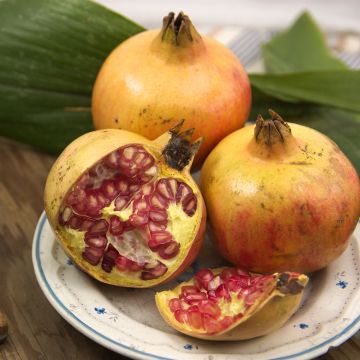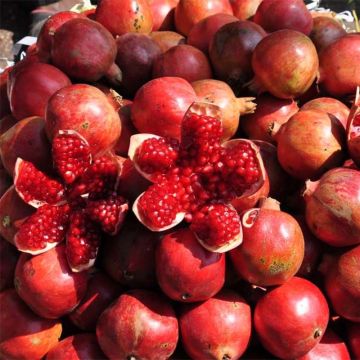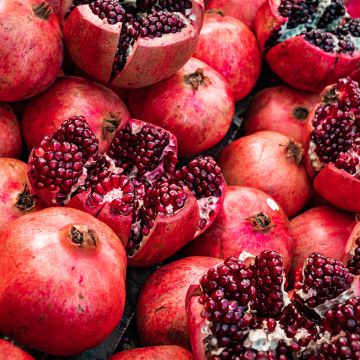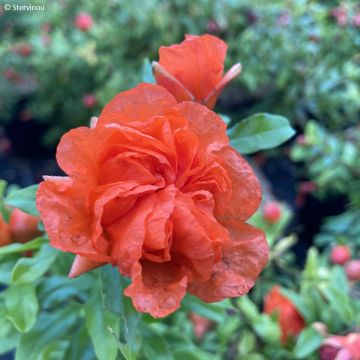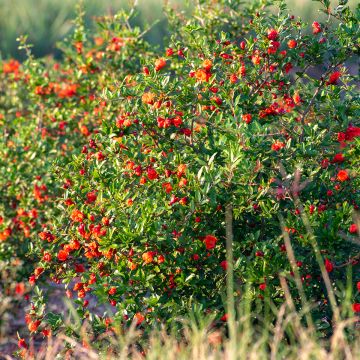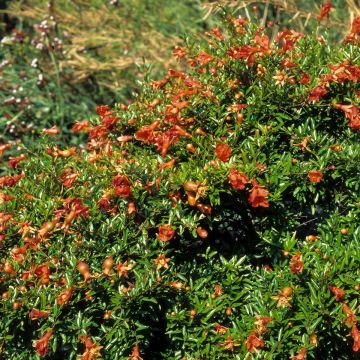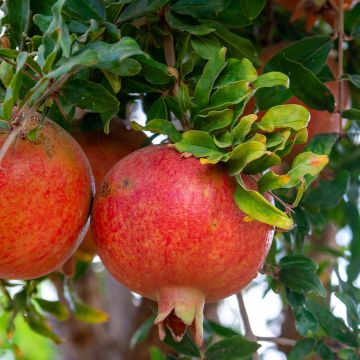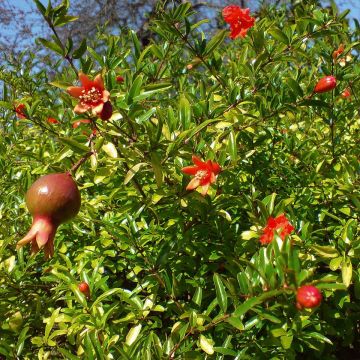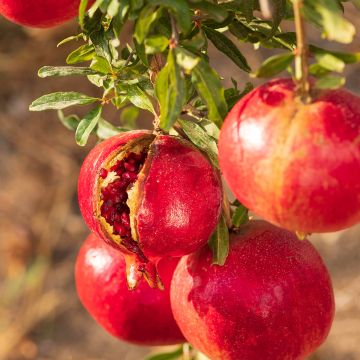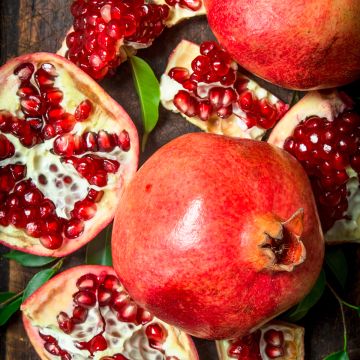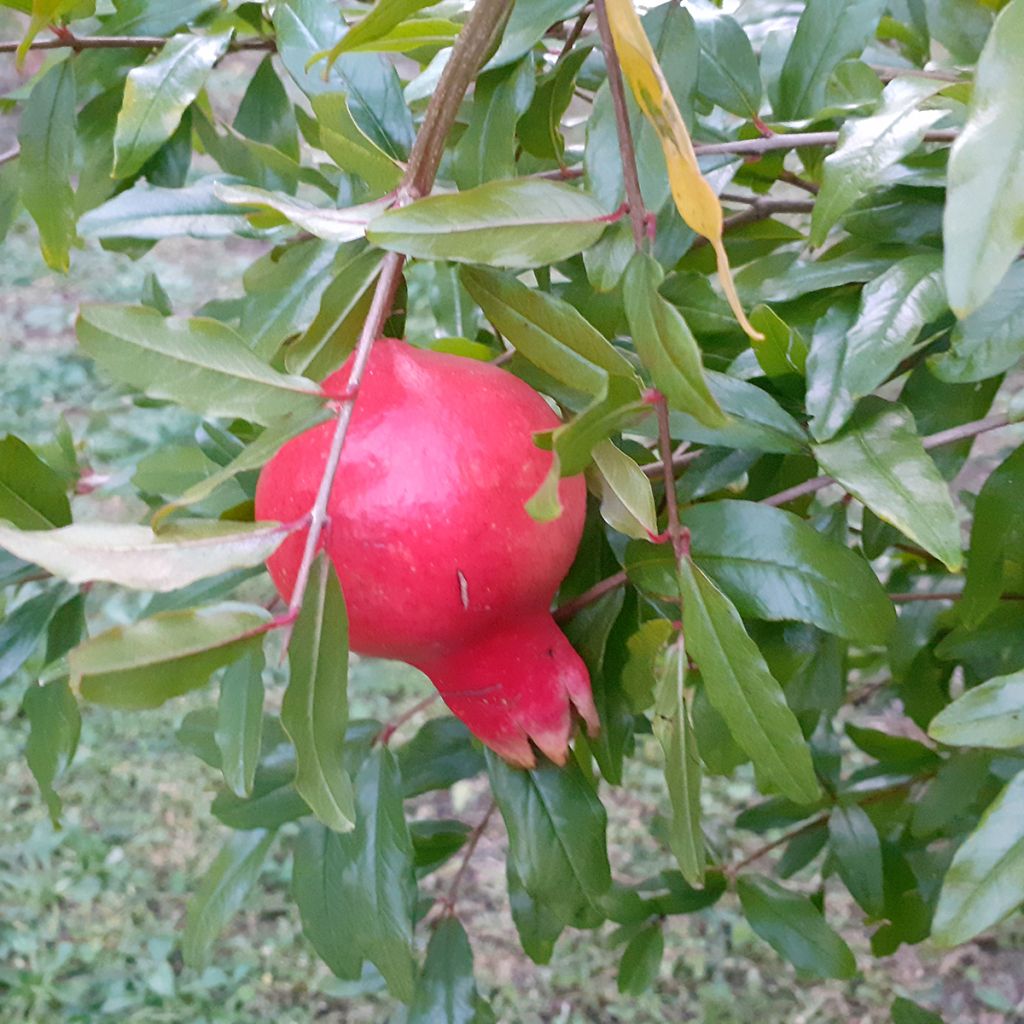

Punica granatum Parfianka - Pomegranate
Punica granatum Parfianka - Pomegranate
Punica granatum Parfianka
Pomegranate
Special offer!
Receive a €20 voucher for any order over €90 (excluding delivery costs, credit notes, and plastic-free options)!
1- Add your favorite plants to your cart.
2- Once you have reached €90, confirm your order (you can even choose the delivery date!).
3- As soon as your order is shipped, you will receive an email containing your voucher code, valid for 3 months (90 days).
Your voucher is unique and can only be used once, for any order with a minimum value of €20, excluding delivery costs.
Can be combined with other current offers, non-divisible and non-refundable.
Why not try an alternative variety in stock?
View all →This plant carries a 6 months recovery warranty
More information
We guarantee the quality of our plants for a full growing cycle, and will replace at our expense any plant that fails to recover under normal climatic and planting conditions.

Description
The 'Parfianka' pomegranate tree offers a generous harvest of large, round pomegranates, weighing between 240 and 430 grams with a diameter of 10 to 14 cm. Their thick and shiny skin has a dark red hue when ripe. Inside, the fruit is divided into several chambers containing juicy reddish pulp with a sweet flavour and few seeds that are tender and soft. The juice colour is a deep burgundy red.
Parfianka is resistant to bursting and practically seedless, delicious eaten fresh from the tree. It gives a very pleasant sensation in the mouth. It is famous for its exceptional nutritional properties, refreshing, thirst-quenching, low in calories, and rich in vitamins, minerals, and antioxidants. A long and hot summer period is necessary to ensure optimal ripening of the fruits of this variety. Its moderate growth makes it suitable for small gardens, and its attractive orange flowers attract pollinating insects. It is best to plant this variety in spring, when the climate warms up, in deep and well-drained soil, even if it is relatively dry.
Punica granatum, more commonly known as the Pomegranate tree, Balaustier, Carthage Apple, or Punic Apple, is a small fruit tree belonging to the Lythraceae family (previously included in the Punicaceae family). Originating in Persia more than 5000 years ago, the pomegranate tree can be found throughout history in Egypt, Greece, Africa, and then in Spain. It is cultivated from Asia to Europe. The city of Granada, a crossroads of Arab and Andalusian civilizations, located in southern Spain, owes its name to the presence of the pomegranate tree, brought by the Moors and widely planted in the mythical gardens of the Alhambra palace. This tree also adorned the hanging gardens of Babylon, and the Romans discovered it in Carthage, naming it the Carthage Apple. It is a species with a long lifespan, capable of living up to 200 years.
The 'Parfianka' variety originates from Central Asia, more specifically from Turkmenistan where its cultivation is ancient, under a continental climate with slightly harsh and cold winters and very hot summers. It is a very productive variety, with abundant and regular fruiting, but it takes about 5 to 7 years to start bearing fruit. 'Parfianka' first forms a clump of thorny and tangled branches in its youth, showing fairly rapid growth until maturity, which does not occur before the age of 5-6 years. The adult plant develops at a much slower pace, forming a small tree 4 m tall and with a minimum spread of 2.50 to 3 m, with a spreading and rounded habit after a few years. From a clump, if care is taken to prune the lower branches, it becomes a tree with a trunk that has a twisted appearance, reminiscent of olive trees. Its deciduous foliage is composed of small ovate, 4 to 7 cm long and 1 to 2 cm wide, shiny and very bright green leaves. They emerge bronze to purple in spring and have beautiful golden-yellow to reddish-orange autumn colours before falling. The pomegranate tree is monoecious, meaning it bears both male flowers that produce pollen and female flowers that will produce fruits. Flowering occurs in June-July, and sporadically continues throughout the summer. The flowers are about 4 cm in diameter. They are composed of crumpled, beautiful orange petals tinged with red, emerging from a thick waxy calyx that already resembles the future pomegranate. It is a fairly cold-resistant variety, capable of withstanding temperatures around -15/-18 °C. Late frosts in April-May can affect flowering and hinder fruit production. The pomegranate tree is self-fertile, with male and female flowers pollinating each other. It does not require a companion to bear fruit, but the presence of another variety of pomegranate nearby will increase production.
Harvesting takes place in October, depending on the climate. The fruits can be consumed as soon as they are picked, as they ripen. The pomegranate is ripe when the skin is shiny red and cracks. Do not wait for the fruit to burst. Another sign of ripeness is visible when the small petal-shaped appendages at the end of the fruit are turned or even curled inward. The fruit's skin consists of a hard and red outer skin, and a thick, spongy, whitish inner skin. The inside of the fruit is divided into chambers. Each chamber contains a transparent and sticky envelope called an "aril" that contains numerous seeds. The seeds and aril are edible. The pomegranate can be cutin half and eaten fresh with a small spoon, used as a garnish for fruit salads or as a sauce to accompany meat or fish. You can extrac the juice to enjoy all the benefits of this fruit. The seeds, on the other hand, yield a good oil for cosmetics. The fresh seed is tender and can be eaten raw. After drying, it is used as a seasoning in dal, fried samosas, and stuffings. It is important to harvest the fruits only when they are ripe, as they do not ripen further after harvest.
Rich in water, the pomegranate is refreshing and thirst-quenching. It can be consumed fresh from the tree or transformed into juice, especially since the health benefits are higher than those of the fruit itself. Known for its richness in antioxidants, it is also rich in vitamins A, C, and E, fiber, as well as minerals such as calcium, iron, folic acid, and potassium. The fruits can be stored for a few weeks to several months after harvest, in the refrigerator, at a temperature of 1 to 3 °C.
Among the varieties of pomegranate trees, the 'Parfianka' Pomegranate tree is prized for its delicious fruits and its decorative appeal. It is easy to grow and resistant to diseases and thrives in places where olive trees and fig trees also prosper, provided it is well protected. However, proper development and fruit ripening require sufficient sunlight and warmth. It is a superb plant to have as a solitary tree on a lawn and in a flower bed, a diverse hedge, or near an orchard. In warm climates, it blends perfectly with other Mediterranean fruit trees such as: Fig tree, Olive tree, Japanese Medlar, Jujube tree, Chilean Guava (Myrtle ugni), Almond tree, and Mulberry tree.
Report an error about the product description
Plant habit
Fruit
Flowering
Foliage
Botanical data
Punica
granatum
Parfianka
Punicaceae
Pomegranate
Cultivar or hybrid
Other Punica - Pomegranate
View all →Planting and care
Plant Punica granatum 'Parfianka' in spring, when all risk of frost has passed in a cool region, but preferably in autumn, in a hot and dry climate. Plant it in a very sunny and sheltered location, or in partial shade in a hot climate, in a deep, well-drained soil, even limestone. While it is very resistant to drought once established and can tolerate arid conditions, it will only reach its full potential and bear abundant fruit in soil that is sufficiently moist at depth. It is resistant to sea spray.
Monitor watering during the first two summers. It will appreciate a compost addition and a thick layer of dead leaves, especially during the first two winters in slightly colder regions. Pruning in early spring is not essential, but it can help shape a small tree with a single trunk or 3 or 4 trunks more quickly. Keep the most vigorous stem(s) in a young plant and remove the others. In the following years, systematically remove the branches that grow on the small trunk(s) until the desired height is reached.
When grown in a pot, fruit-bearing pomegranate should be watered generously every 10 days. Never let stagnant water accumulate.
An application of fertiliser rich in nitrogen and phosphorus is recommended for the proper development of the pomegranate. In a pot, the pomegranate should be fed with a fruit tree fertiliser.
The pomegranate does not have any specific enemies. It is a very robust species. Some scale insects may settle on it, but they do not cause significant damage to the tree. If necessary, treat with white oils in winter.
Planting period
Intended location
Care
This item has not been reviewed yet - be the first to leave a review about it.
Haven't found what you were looking for?
Hardiness is the lowest winter temperature a plant can endure without suffering serious damage or even dying. However, hardiness is affected by location (a sheltered area, such as a patio), protection (winter cover) and soil type (hardiness is improved by well-drained soil).

Photo Sharing Terms & Conditions
In order to encourage gardeners to interact and share their experiences, Promesse de fleurs offers various media enabling content to be uploaded onto its Site - in particular via the ‘Photo sharing’ module.
The User agrees to refrain from:
- Posting any content that is illegal, prejudicial, insulting, racist, inciteful to hatred, revisionist, contrary to public decency, that infringes on privacy or on the privacy rights of third parties, in particular the publicity rights of persons and goods, intellectual property rights, or the right to privacy.
- Submitting content on behalf of a third party;
- Impersonate the identity of a third party and/or publish any personal information about a third party;
In general, the User undertakes to refrain from any unethical behaviour.
All Content (in particular text, comments, files, images, photos, videos, creative works, etc.), which may be subject to property or intellectual property rights, image or other private rights, shall remain the property of the User, subject to the limited rights granted by the terms of the licence granted by Promesse de fleurs as stated below. Users are at liberty to publish or not to publish such Content on the Site, notably via the ‘Photo Sharing’ facility, and accept that this Content shall be made public and freely accessible, notably on the Internet.
Users further acknowledge, undertake to have ,and guarantee that they hold all necessary rights and permissions to publish such material on the Site, in particular with regard to the legislation in force pertaining to any privacy, property, intellectual property, image, or contractual rights, or rights of any other nature. By publishing such Content on the Site, Users acknowledge accepting full liability as publishers of the Content within the meaning of the law, and grant Promesse de fleurs, free of charge, an inclusive, worldwide licence for the said Content for the entire duration of its publication, including all reproduction, representation, up/downloading, displaying, performing, transmission, and storage rights.
Users also grant permission for their name to be linked to the Content and accept that this link may not always be made available.
By engaging in posting material, Users consent to their Content becoming automatically accessible on the Internet, in particular on other sites and/or blogs and/or web pages of the Promesse de fleurs site, including in particular social pages and the Promesse de fleurs catalogue.
Users may secure the removal of entrusted content free of charge by issuing a simple request via our contact form.
The flowering period indicated on our website applies to countries and regions located in USDA zone 8 (France, the United Kingdom, Ireland, the Netherlands, etc.)
It will vary according to where you live:
- In zones 9 to 10 (Italy, Spain, Greece, etc.), flowering will occur about 2 to 4 weeks earlier.
- In zones 6 to 7 (Germany, Poland, Slovenia, and lower mountainous regions), flowering will be delayed by 2 to 3 weeks.
- In zone 5 (Central Europe, Scandinavia), blooming will be delayed by 3 to 5 weeks.
In temperate climates, pruning of spring-flowering shrubs (forsythia, spireas, etc.) should be done just after flowering.
Pruning of summer-flowering shrubs (Indian Lilac, Perovskia, etc.) can be done in winter or spring.
In cold regions as well as with frost-sensitive plants, avoid pruning too early when severe frosts may still occur.
The planting period indicated on our website applies to countries and regions located in USDA zone 8 (France, United Kingdom, Ireland, Netherlands).
It will vary according to where you live:
- In Mediterranean zones (Marseille, Madrid, Milan, etc.), autumn and winter are the best planting periods.
- In continental zones (Strasbourg, Munich, Vienna, etc.), delay planting by 2 to 3 weeks in spring and bring it forward by 2 to 4 weeks in autumn.
- In mountainous regions (the Alps, Pyrenees, Carpathians, etc.), it is best to plant in late spring (May-June) or late summer (August-September).
The harvesting period indicated on our website applies to countries and regions in USDA zone 8 (France, England, Ireland, the Netherlands).
In colder areas (Scandinavia, Poland, Austria...) fruit and vegetable harvests are likely to be delayed by 3-4 weeks.
In warmer areas (Italy, Spain, Greece, etc.), harvesting will probably take place earlier, depending on weather conditions.
The sowing periods indicated on our website apply to countries and regions within USDA Zone 8 (France, UK, Ireland, Netherlands).
In colder areas (Scandinavia, Poland, Austria...), delay any outdoor sowing by 3-4 weeks, or sow under glass.
In warmer climes (Italy, Spain, Greece, etc.), bring outdoor sowing forward by a few weeks.






























